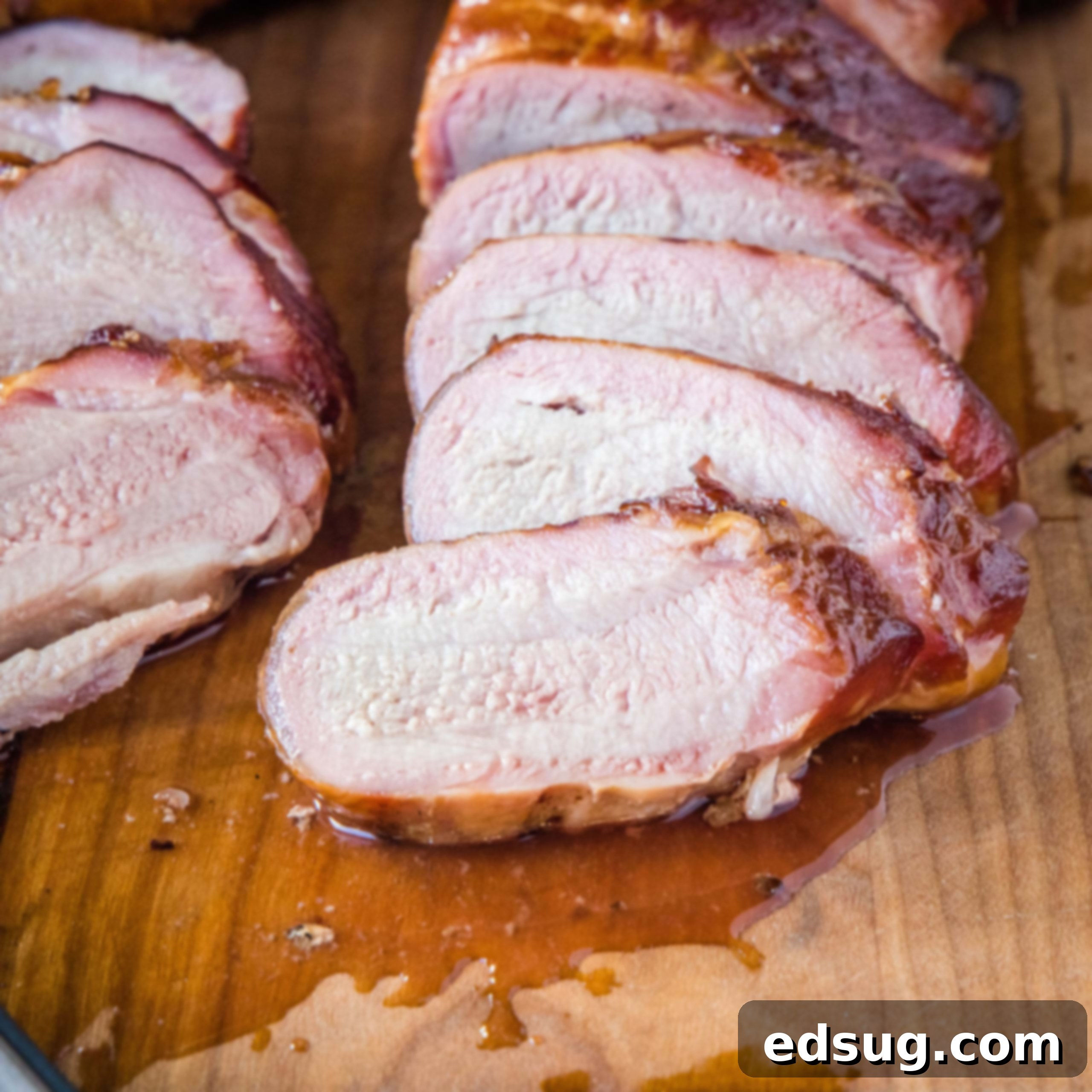Mastering Smoked Pork Tenderloin: Your Guide to Tender, Juicy, and Flavorful Results
This post is sponsored by Best Food Facts and United Soybean Board. All thoughts and opinions are 100% my own.
There’s nothing quite like the irresistible aroma and succulent taste of perfectly smoked pork tenderloin. This incredibly versatile protein is a fantastic choice for any night of the week, offering a delicious, flavorful meal that’s surprisingly easy to prepare. Whether you’re a seasoned pitmaster or just starting your smoking journey, this guide will walk you through creating a tender, juicy smoked pork tenderloin that’s bursting with flavor, thanks in large part to a simple yet powerful marinade featuring one of our favorite pantry staples: soy sauce!
Recently, I had the incredible opportunity to visit Des Moines with Best Food Facts and the United Soybean Board. During my trip, I learned so much about sustainable soybean farming, the incredible nutritional benefits of soy, and its vital role in modern agriculture. It truly opened my eyes to the journey of ingredients from farm to table. Today, I’m thrilled to share a fantastic summer dinner recipe that highlights one of my absolute favorite soy products: soy sauce. Its savory depth elevates this pork tenderloin to another level!

The Power of Soy Sauce in Marinades: More Than Just Flavor
Soybeans are a truly remarkable ingredient. Naturally cholesterol-free, they are packed with essential nutrients, making them a cornerstone of healthy diets worldwide. They are particularly high in protein and fiber, and a great source of vitamin B6, phosphorus, and iron. Beyond their basic nutritional profile, soy is rich in antioxidants and isoflavones, compounds known for their potential health benefits.
Soy sauce, derived from fermented soybeans, brings a complex umami flavor that perfectly complements pork. It’s not just about taste; soy sauce acts as an excellent tenderizer, helping to break down the meat fibers and ensure a truly juicy result. While it can be high in sodium, choosing a reduced-sodium variety, as I do for my kitchen, allows you to enjoy its rich flavor while managing sodium intake. This simple swap ensures your marinade is both delicious and balanced, contributing to a healthier meal.
Crafting the Perfect Smoked Pork Tenderloin Marinade
When it comes to smoking, many people opt for a simple dry rub to let the natural smoke flavor shine. However, for pork tenderloin, a marinade offers a distinct advantage. Because tenderloin is a very lean cut, it benefits greatly from the moisture and tenderizing properties of a liquid marinade. This not only infuses the meat with incredible flavor but also helps keep it exceptionally juicy throughout the smoking process, preventing it from drying out.
Our smoked pork tenderloin marinade is a harmonious blend of sweet, savory, and aromatic notes, designed to penetrate deep into the meat. The beauty of this marinade lies in its simplicity and the depth of flavor it imparts. You can let the pork tenderloin soak up these delicious flavors for as little as one hour or, for maximum flavor penetration and convenience, marinate it overnight for up to 24 hours. This makes it an ideal option for meal prep, allowing you to get ahead of dinner plans.
Marinade Ingredients:
- Soy Sauce (Low Sodium): Provides a deep umami flavor and helps tenderize the meat. Opt for low-sodium to control saltiness.
- Honey: Adds a touch of natural sweetness that balances the savory soy sauce and contributes to a beautiful caramelized crust.
- Olive Oil: Helps distribute fat-soluble flavors and keeps the pork moist.
- Brown Sugar: Enhances sweetness and aids in caramelization, giving the pork a rich, appealing color.
- Garlic: A foundational aromatic that adds pungent, savory notes. Minced fresh garlic is always best!
- Onion Powder: Provides another layer of savory depth and complements the garlic without adding extra moisture.

How To Smoke Pork Tenderloin: A Step-by-Step Guide
Smoking pork tenderloin is a straightforward process that yields incredibly delicious results. Follow these steps for a perfect cook every time:
- Prepare the Marinade: In a medium bowl or a large resealable food storage bag, thoroughly mix together the honey, olive oil, brown sugar, low-sodium soy sauce, minced garlic, and onion powder until well combined.
- Marinate the Pork: Place the pork tenderloins into the prepared food storage bag with the marinade. Seal the bag, pressing out as much air as possible, and gently squish the bag around to ensure the pork is completely coated. Place the marinated pork in the refrigerator for at least 1 hour, or preferably 4-8 hours for maximum flavor. You can marinate it for up to 24 hours.
- Preheat Your Smoker: About 15-20 minutes before you plan to smoke, preheat your smoker to a consistent 225º F (107º C). Ensure your smoker is at a stable temperature before adding the meat. Choose your favorite wood pellets or chips – apple, cherry, pecan, or hickory all work wonderfully with pork.
- Smoke the Pork Tenderloin: Remove the pork tenderloins from the marinade (discarding any excess marinade) and place them directly onto the smoker grate. Close the lid and cook for approximately 60-90 minutes. The exact time will vary based on the thickness of your tenderloins and the consistency of your smoker’s temperature.
- Monitor Internal Temperature: The most critical step is cooking to temperature, not just time. Use a reliable meat thermometer to check the internal temperature of the thickest part of the pork. The target internal temperature for pork tenderloin is 145º F (63º C).
- Rest and Serve: Once the pork reaches 145º F, carefully remove it from the smoker and let it rest on a cutting board, loosely tented with foil, for 3-5 minutes. This resting period is crucial as it allows the juices to redistribute throughout the meat, ensuring a tender and incredibly juicy final product. After resting, slice the tenderloin into medallions and serve. It pairs wonderfully with your favorite barbecue sauce, or simply enjoyed on its own.
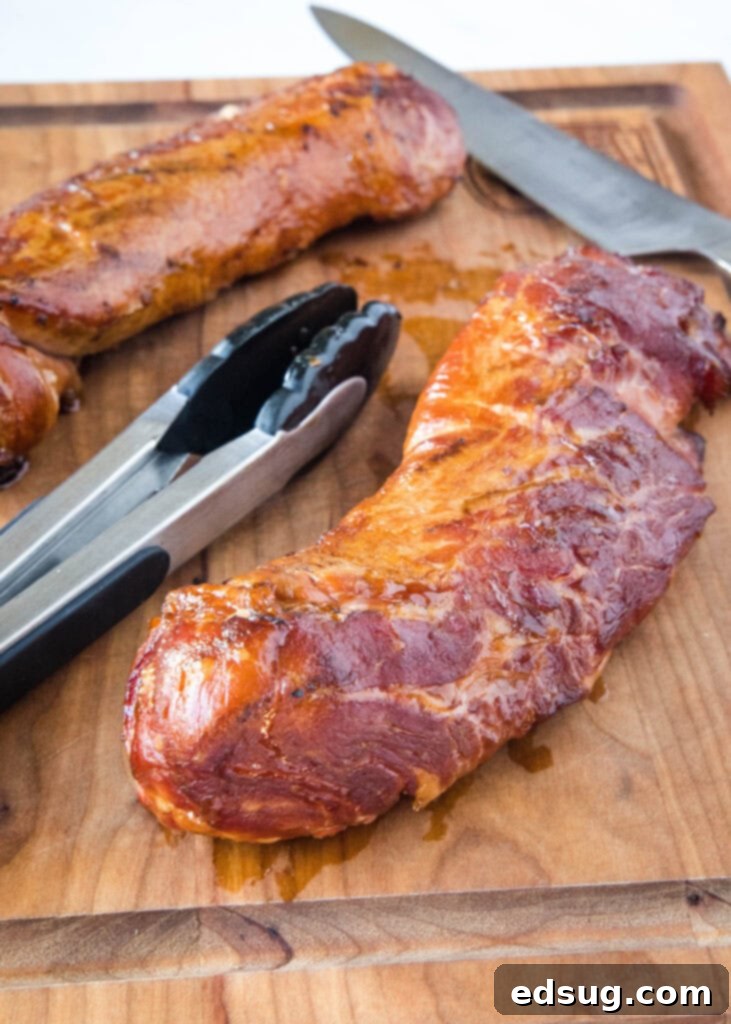
How Long To Smoke Pork Tenderloin: Factors Affecting Cook Time
While a general guideline for smoking pork tenderloin is 60-90 minutes, it’s essential to understand that this is an approximation. Several factors can influence the actual cooking time, making a meat thermometer your most valuable tool. The primary determinants include:
- Size and Thickness: Pork tenderloins vary in size. Those purchased from a standard grocery store might be smaller and cook quicker than larger cuts found at a wholesale club or specialty butcher. Thicker tenderloins will naturally require more time.
- Smoker Consistency: The ability of your smoker to maintain a consistent temperature throughout the cook is crucial. Fluctuations in temperature, due to opening the lid frequently, weather conditions, or the type of smoker (pellet, electric, charcoal), will impact the overall cooking time.
- Starting Temperature: If your pork tenderloin is very cold from the refrigerator, it will take longer to come up to temperature than if it’s been allowed to sit at room temperature for a short period before smoking.
- Ambient Temperature: Smoking in colder weather will often extend the cooking time as the smoker works harder to maintain its internal temperature.
As with smoking any cut of meat, the golden rule is always to cook to the target internal temperature, not solely by time. This ensures food safety and guarantees the best texture and juiciness.
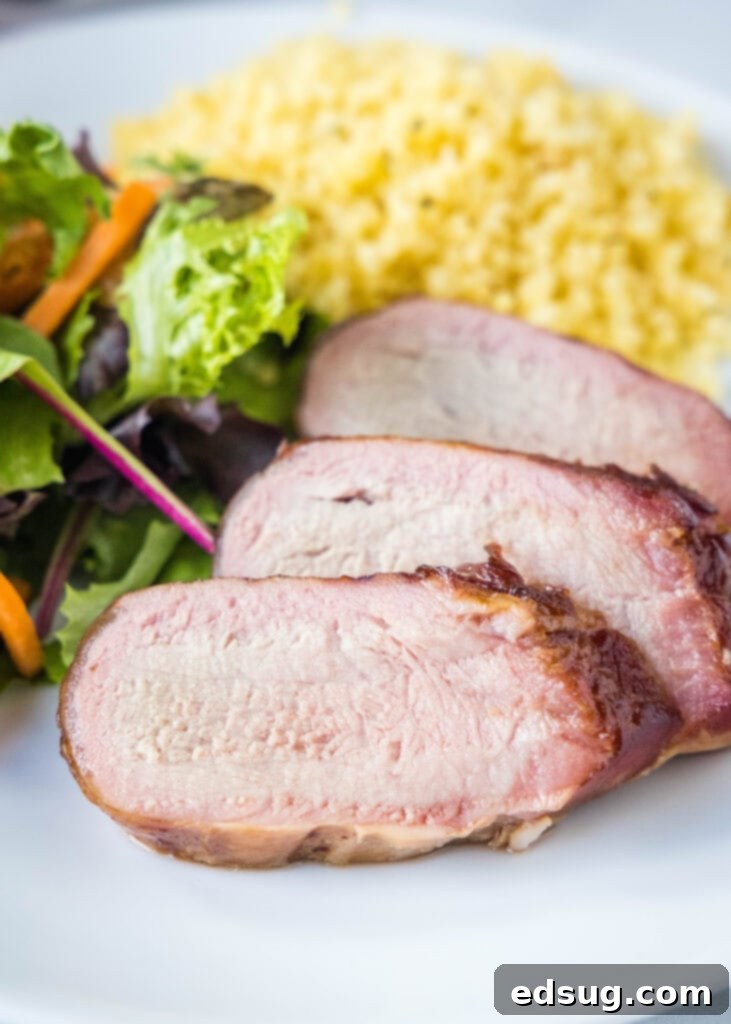
Achieving Perfect Doneness: Smoked Pork Tenderloin Internal Temperature
For safe consumption and optimal tenderness, the United States Department of Agriculture (USDA) recommends cooking pork to an internal temperature of 145º F (63º C), followed by a three-minute rest. This critical temperature ensures that any harmful bacteria are eliminated while preserving the meat’s moisture and flavor.
Many people avoid pork because they’ve had dry, tough experiences in the past. This is almost always due to overcooking. Pork tenderloin is a lean cut, meaning it has very little fat to keep it moist if cooked beyond its ideal temperature. When you cook it precisely to 145º F, you’ll be amazed at how incredibly juicy, tender, and flavorful it turns out. Don’t be alarmed if there’s a slight pinkish hue in the center; this is perfectly normal and indicates a perfectly cooked, moist tenderloin, not undercooked meat.
To accurately monitor the internal temperature throughout the cooking process, a high-quality meat thermometer is indispensable. I personally rely on the Thermapen Mk4. It’s renowned for its incredible accuracy and rapid readings, which are crucial when dealing with smaller cuts like tenderloin where temperatures can rise quickly. Investing in a good thermometer ensures you hit that perfect 145ºF mark every single time, guaranteeing consistently succulent results.
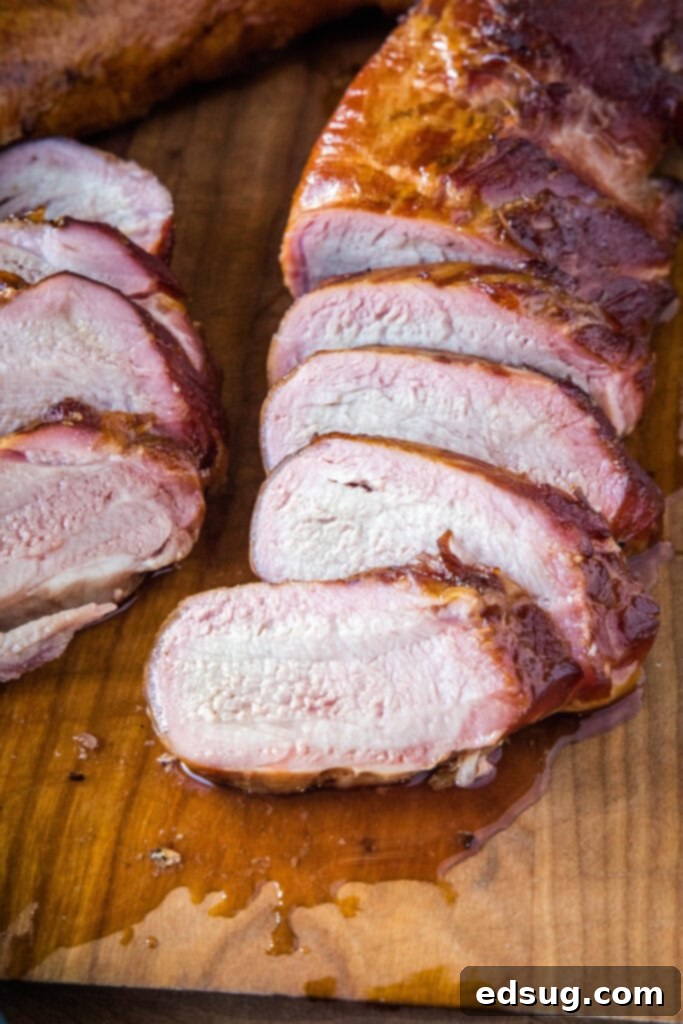
Delicious Sides to Complement Smoked Pork Tenderloin
A perfectly smoked pork tenderloin deserves equally delicious accompaniments. Here are some of my favorite side dishes that pair wonderfully with the rich, smoky flavors of this main course:
- Cheddar Broccoli Rice
- Smoked Potatoes
- Caprese Pasta Salad
- Baked Beans
Pork Tenderloin vs. Pork Loin: Understanding the Differences
It’s common for home cooks to confuse pork tenderloin with pork loin, but these are distinctly different cuts of meat, requiring different cooking approaches. Understanding their characteristics is key to achieving the best results for your smoked dishes.
Pork Tenderloin: This cut is long, narrow, and comes from along the backbone of the pig. It is incredibly lean and very tender, hence its name. Pork tenderloin cooks quickly due to its small size and lack of fat. It has a slightly stronger, more concentrated pork flavor. Even when cooked to the recommended 145º F, it often retains a pinkish hue in the center, which is a sign of perfect doneness and juiciness, rather than being undercooked.
Pork Loin: In contrast, pork loin is a much wider, flatter, and significantly larger cut of meat. It can sometimes be found sold bone-in, resembling a roast. While still a tender cut, it has a more mild flavor profile compared to the tenderloin. Pork loin is typically thicker and has a larger surface area, sometimes with a fat cap, making it more akin to a roast. This means it will take considerably longer to smoke than a tenderloin. If you’re looking to smoke a pork loin, check out this detailed guide for a fantastic Smoked Pork Loin recipe and more information.
During my trip to Des Moines, I learned about the symbiotic relationship between pig farming and soybean cultivation. It was fascinating to discover that a significant number of pig farmers, about 64%, also grow soybeans on their farms. These soybeans are then used to feed the pigs, providing them with essential protein and nutrients. In turn, the manure from the pigs is utilized as a natural fertilizer, enriching the soil and helping the soybean crops thrive. This integrated approach is a prime example of sustainable farming practices, demonstrating how different agricultural elements can work together to create a more efficient and environmentally friendly food system.
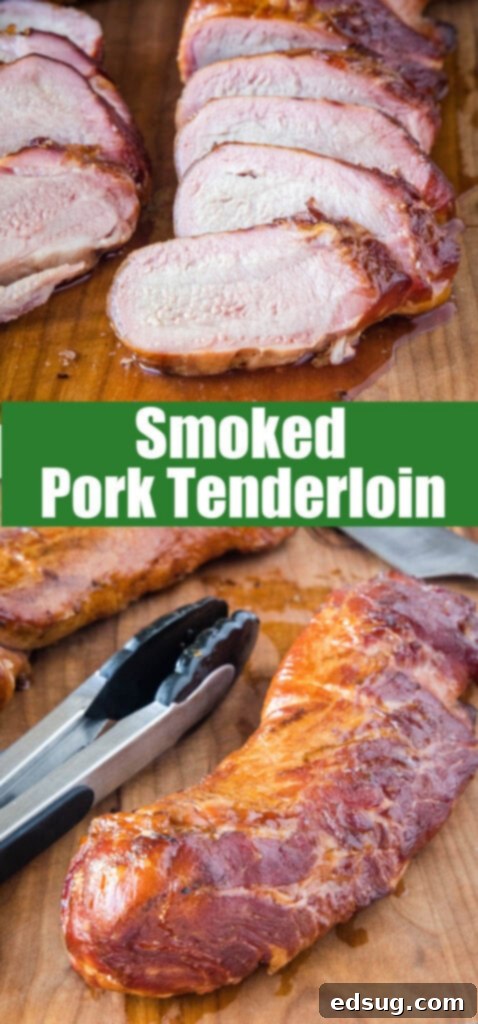
Explore More Delicious Pork Dinner Recipes
Pork is an incredibly versatile meat, perfect for a wide variety of dinner recipes. If you loved this smoked pork tenderloin, you might enjoy these other flavorful pork dishes:
- Oven Baked Pork Chops
- Pork Lo Mein
- Smoked Pork Belly
- Slow Cooker Pork Roast
- Gyoza
- Instant Pot Pulled Pork
- Smothered Pork Chops

Smoked Pork Tenderloin
Ingredients
- 2 1- pound pork tenderloins
- 2 Tablespoons honey
- 1 Tablespoon olive oil
- 1 Tablespoon brown sugar
- 1/2 cup low sodium soy sauce
- 4 cloves garlic, minced
- 1 teaspoon onion powder
Instructions
- Mix together the honey, olive oil, brown sugar, soy sauce, garlic and onion powder. Add the pork and marinade to a food storage bag, seal and squish it around to fully coat the pork.
- Store in the fridge for at least an hour, up to 24 hours.
- Preheat smoker to 225º F.
- Place the pork tenderloins directly on the smoker grate and cook for 60-90 minutes, until the internal temperature reaches 145º F.
- Let the pork rest for 3 minutes, and then slice to serve. It is great topped with your favorite barbecue sauce.
Nutrition
Nutrition information is automatically calculated, so should only be used as an approximation.
Additional Info
I created a fun group on Facebook, and I would love for you to join us! It’s a place where you can share YOUR favorite recipes, ask questions, and see what’s new at Dinners, Dishes and Desserts (so that you never miss a new recipe)!
Be sure to follow me on Instagram and tag #dinnersdishes so I can see all the wonderful DINNERS, DISHES, AND DESSERTS recipes YOU make!
Be sure to follow me on my social media, so you never miss a post!
Facebook | Twitter | Pinterest | Instagram
.
